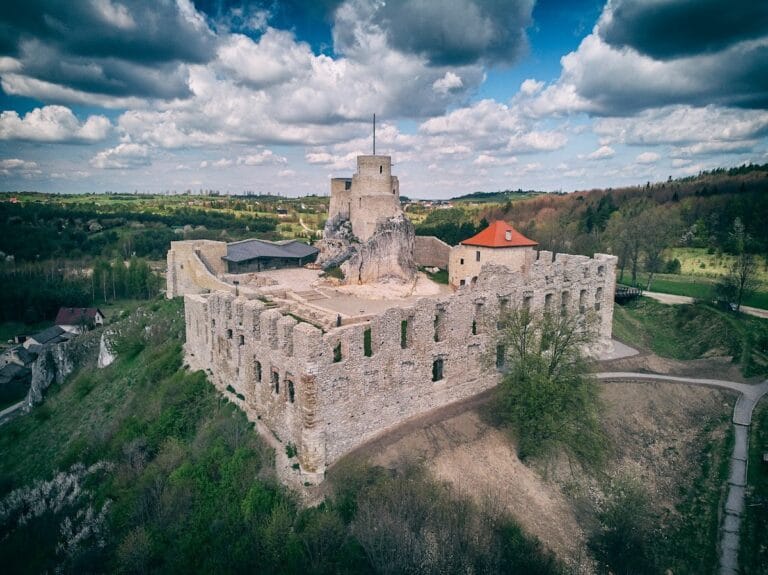Ogrodzieniec Castle: A Historic Fortress in Podzamcze, Poland
Visitor Information
Google Rating: 4.7
Popularity: Very High
Google Maps: View on Google Maps
Official Website: www.zamek-ogrodzieniec.pl
Country: Poland
Civilization: Medieval European
Remains: Military
History
Ogrodzieniec Castle stands in the municipality of Podzamcze, Poland, and was originally established by the Polish civilization. The earliest fortifications on this site date back to the early 12th century during the reign of Duke Bolesław III Wrymouth. These initial defenses consisted mainly of wooden structures and earthworks, commonly known as Wilcza Szczęka, or “Wolf’s Jaw.” This early stronghold was likely destroyed during the Mongol invasion of Poland in 1241, a devastating incursion that led to widespread destruction.
In the 14th century, a significant transformation took place when King Casimir III the Great ordered the construction of a stone castle on the site, replacing the earlier wooden fortifications. The first known administrator during this period was Przedbór of Brzezie, who later became a marshal of the Polish kingdom. His role marked the beginning of the castle’s importance as a strategic and administrative center.
At the close of the 14th century, the castle entered into the possession of Włodek of Harbinowice, a member of the noble Sulima coat of arms family. King Władysław II Jagiełło granted him the castle and its lands in 1386–1387. Włodek and his descendants held the castle for nearly a hundred years, during which they enhanced its defensive features, adapting it to evolving military needs.
Ownership of Ogrodzieniec Castle changed hands multiple times between the late 15th and early 16th centuries. The affluent Salomon family from Kraków, followed by the Rzeszowski and Pilecki families, held the property before it transferred to the Boner family by 1527, a transfer connected to settlements of debts and pledges. Seweryn Boner, an influential nobleman, undertook a comprehensive reconstruction of the medieval fortress between 1530 and 1547. He remodeled the castle in the Renaissance style, earning it the nickname “Little Wawel,” a reference to the royal Wawel Castle in Kraków.
In 1562, through marriage, the castle passed into the hands of Jan Firlej, the Great Crown Marshal of Poland. Firlej continued the strengthening of the castle’s defenses by adding bastions, a bulwark, and a dry moat, adapting the fortress to new military technologies. During the Polish succession conflict in 1587, forces loyal to Archduke Maximilian of Austria seized the castle. Despite the occupation, the fortress endured without serious damage.
The mid-17th century brought considerable hardship to Ogrodzieniec during the Swedish Deluge, a period of invasions and warfare. The castle was occupied and extensively plundered, suffering partial destruction. Later, starting in 1669, Kraków castellan Stanisław Warszycki led efforts to partially rebuild and repair the damaged fortress.
In 1702, the castle suffered a devastating fire caused by Swedish troops commanded by King Charles XII. This blaze destroyed over half of Ogrodzieniec, and following the event, the castle was never fully restored. By the late 18th century, the fortress had fallen into neglect. Tomasz Jakliński purchased the property in 1784 but dismantled portions of the castle to provide building materials for nearby churches. Around 1810, the final inhabitants left the diminished fortress.
Throughout the 19th century, the castle’s ruins were further dismantled by subsequent owners like Ludwik Kozłowski, who used and sold its stonework, accelerating the decay. The castle changed ownership several times, with the Wołczyński family acquiring it in 1899, marking the final private ownership before the 20th century.
Following World War II, Ogrodzieniec Castle was nationalized. Between 1949 and 1973, restoration and conservation initiatives were undertaken to preserve the ruins. This work aimed to stabilize the remains and manage the site as a permanent ruin, allowing its history to endure.
Remains
Ogrodzieniec Castle occupies the summit of Castle Hill, rising 515.5 meters above sea level, making it the tallest hill in the Kraków-Częstochowa Upland. The fortress was originally surrounded by natural defenses, with steep cliffs on three sides providing strong protection. Its perimeter was enclosed by stone walls, and access was through a narrow entrance flanked by sturdy towers that controlled passage into the castle.
The castle’s layout included a citadel, the most heavily fortified area, and an extensive complex circumscribed by robust stone walls. During the Renaissance rebuilding from 1530 to 1547, a new wing was added, transforming much of the medieval Gothic fortress into a residential space aligned with Renaissance architectural ideals. To reinforce its defense, bastions and an outer bulwark were constructed, complemented by a dry moat designed to hinder attackers.
Today, visitors can observe the ruins comprising fragments of walls, several towers, and remains of residential buildings. Notable features include remnants of the castle bridge and an inner courtyard, which reflect the complex’s former arrangement. The defensive walls show the outlines of bastions and other protective structures that enhanced the fortress’s security.
Architectural elements from the castle have been reused nearby in a chapel located in the village of Podzamcze. Among these are details such as a portal, ornamental volutes (scroll-like decorations), cornices, and a keystone from the chapel’s original structure. Additionally, a cannonball believed to date from the Swedish Deluge and a Renaissance statue of the Virgin Mary were incorporated into this religious building, linking the site’s martial past with local spiritual heritage.
Inside the ruins, some Renaissance frescoes depicting lilies remain visible on the lowest floor of the castle. These painted decorations provide insight into the artistic styles and symbolic motifs favored during the period of the castle’s Renaissance transformation.
The site has also served as a filming location, with certain large decorative set pieces created for productions remaining on the grounds. For example, elements constructed for Andrzej Wajda’s 2001 film “Revenge” continue to be part of the castle’s visual landscape.
The ongoing preservation of Ogrodzieniec Castle maintains it as a significant ruin, allowing for the study and appreciation of its layered history, from its medieval origins through Renaissance renovations and periods of conflict. The combination of natural topography and built structures illustrates the strategic importance this fortress held in the past.










